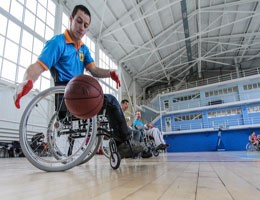
The problem of disability is one of the most acute and urgent problems solved by mankind today. According to WHO statistics, every tenth man on Earth is a disabled person, which makes up 10% of the population of the globe and the dynamics of the spread of disability in society in the near future will not change. Not all people with disabilities have come to terms with their position. Many of them want to lead an active lifestyle and be full -fledged members of society.
The state of a person with disabilities leads to persistent changes in the body, the emergence of physical, social and psychological barriers in achieving a decent level and quality of life. Current trends are the harmonization of public views in relation to disabled people determined the increase in the significance of socializing rehabilitation practices. One of the leading areas of this activity is physical education and sports. The participation of people with disabilities in physical education and sports is not only a means of treatment and rehabilitation, but also the most important condition for increasing self -esteem of their own “I”, awareness of themselves as a potentially useful member of society, as well as ensuring a worthy level and quality of life with disabilities in general.
The importance of physical culture and sports in the life of a disabled person:
- Therapeutic significance: health -improving physical education and sports is a natural form of therapeutic exercises, which can be used as an addition to ordinary methods of physical rehabilitation. It is difficult to overestimate their significance to restore the forces of a disabled person, the ability to coordinate their actions, the development of speed and endurance;
- The psychological significance of sports as a rest: a disabled person should consider each training session not only as a victory, muscle struggle for restoration of strength, but also as a source of joy. Sports have a significant advantage over formal physical exercises - this is a rest factor. Sport as a sample of game activity makes up for the need to express life joy and satisfaction laid down in every person;
- The social significance of physical education and sports: this is a means of social integration of disabled people into society, a powerful incentive to restore or establish contact with the outside world, recognition as equal citizens.
The motor functions of a disabled person involved in sports undergoes changes - a number of positive shifts are noted in the bosom -postal and muscle systems. The basis of the development of training is the improvement of nervous management of all organs, including the heart. As a result of training, strength, balance and mobility of nervous processes increase, which leads to an improvement in the regulation of the body's functions. At the same time, the interaction of motor and autonomic functions is improved and coordinated. Physical exercises in one form or another are shown to almost all disabled people of young and middle age with motor disorders.
The sports life of disabled people is quite diverse. There is practically no sport that would not be available to them. They are engaged in archery, light and heavy athletics, bicycle sports, fencing, judo, football, basketball, volleyball, swimming, table tennis, rugby, ski cross, hockey. Of course, not all disabled athletes become champions. For them, the main thing is not a victory, but participation in sporting events, which is an effective means of improving the quality and restoration of the full active life of people with disabilities.




























